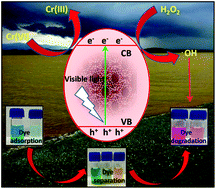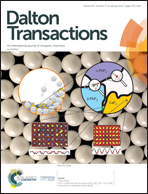Trifunctional metal–organic platform for environmental remediation: structural features with peripheral hydroxyl groups facilitate adsorption, degradation and reduction processes†
Abstract
A Cd(II)-based metal–organic framework (MOF) {[Cd(PA)(4,4′-bpy)2](H2O)}n (where, PA = pamoic acid, and bpy = bipyridine) has been demonstrated to have trifunctional properties, namely as (i) an efficient and selective adsorbent for dyes, (ii) a visible-light-active photocatalyst for the degradation of dyes and (iii) a photocatalyst for Cr(VI) reduction. Hence, this material has a very good potential for application in environmental remediation. In particular, the MOF exhibits excellent selectivity toward cationic methylene blue (MB) dye adsorption and its separation over neutral (neutral red) and anionic (methyl orange) dyes. In addition, the catalyst has also been explored for the photocatalytic degradation of less adsorbed dyes, such as methyl orange (MO) and rhodamine B (RhB). Subsequently, the potential of the presented MOF for the photocatalytic reduction of Cr(VI) under visible light irradiation has also been investigated and the catalyst was found to reduce 95% of Cr(VI) within 3 h. Moreover, simultaneous one-pot photocatalytic reduction of Cr(VI) and dye degradation has been demonstrated with high efficiency using the same catalyst. The mechanism of adsorption could be correlated to the presence of peripheral hydroxyl groups in the MOF and the photocatalytic activity observed under visible light could be attributed to the optical properties of Cd-MOF. In principle, this work could broaden the utilization of single metal organic platform for multifunctional applications toward environmental remediation.



 Please wait while we load your content...
Please wait while we load your content...